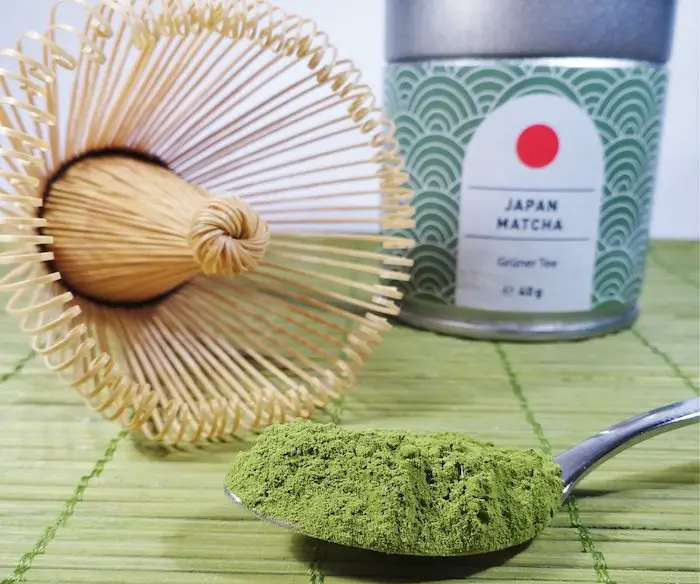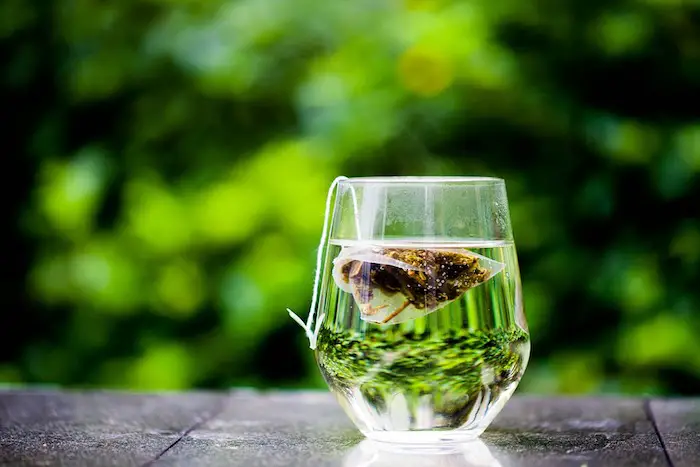We are reader supported. When you purchase through links on our site, we may earn an affiliate commission. Also, as an Amazon affiliate, we earn from qualifying purchases.

While I was re-organizing my tea stash the other day, I realized I had a box of matcha that was over a year old and a month past the expiration date. But when I opened it, the tea inside looked fine. Was my matcha still safe to drink?
Does matcha powder go bad? Matcha powder can go stale, but it never stops being safe to drink. For the best taste, open your matcha right away, and drink it within three to four weeks. Check the smell, color, and flavor to see if your matcha has gone stale.
The truth is that dry goods like tea and coffee don’t really expire like other foods. Still, fresh matcha tea tastes infinitely better. Once you’ve tasted the difference, you’ll understand why I always drink my matcha right away.
Contents
The Shelf Life of Matcha Tea
Matcha is a dry good and doesn’t “go bad” in the traditional sense. Without any moisture, the bacteria that cause food to rot simply can’t grow in your tea container. However, matcha tea still has a shelf life, and it won’t taste the same after it expires.
Matcha is actually made from tea leaves that have been dried and then ground into a fine powder. Just like coffee beans, matcha leaves start to lose their aroma and flavor as soon as they’re ground. This means that you only have so much time from the day the matcha is prepared to enjoy your delicious drink.
Ideal Drinking Time
Matcha starts to lose its flavor as soon as you open the package. This means you should drink the tea quickly to experience the full matcha taste.
Fresh matcha should be drunk within three to four weeks. This timer starts when you open the container. Matcha that more than one month old is still safe to drink, but it won’t have the same vibrant taste or smell.
However, it’s important to note that sealed matcha also loses its flavor while it’s sitting on the shelf. A brand-new box of matcha will taste much better than one that’s six months old. For the best results, drink your new box of matcha right away.
Expiration Dates
Most Matcha containers are printed with an expiration date. This date is determined by the manufacturer and is usually a good indicator of whether the tea is still good to drink.
In general, matcha expires one year after it’s purchased. The flavor is at its best within the first month, but the tea should stay reasonably fresh until the expiration date has passed. The tea may also expire more quickly if you don’t store it correctly.
Some matcha brands state that their product is good for up to two years after packaging. The actual expiration date of matcha tea depends on how well the tea was packaged and how much taste you care to preserve. The printed date as a good guideline, but you should also use your senses to decide if the tea is still fresh.
Matcha vs. Bagged Tea
Both matcha powders and bagged teas usually last about a year. However, matcha will lose its taste within the first few weeks, but bagged tea holds its flavor for much longer. This difference comes from the way the teas are prepared and served.

To brew a normal cup of tea, you need to submerge the leaves in hot water and let them steep for 1-3 minutes. The tea leaves are then strained from the water before the drink is served.
In comparison, matcha powder is actually dissolved in hot water. This guarantees that you’ll get the full flavor of matcha leaves in every sip. However, it also means that the freshness of the matcha is much more relevant to the taste.
As tea gets older, it starts to lose its flavor and develop a bitter taste. A bag of tea will age at the same rate as a scoop of matcha powder. However, because the matcha is drunk more directly, you are far more likely to notice that dry, “stale” flavor.
How to Tell if Your Matcha Is Fresh
Matcha doesn’t really go bad, but it can definitely go stale and lose its flavor. Whether you opened your matcha recently or let the expiration date drift by, you can check the color, smell, flavor, and texture to see if it’s still good to drink.
- Color: Matcha is known for its vibrant green color. The fresher the matcha is, the greener it will be. Stale matcha looks pale and gray, especially when you compare it to fresh tea. However, some matcha products include green food dye, so the color isn’t always a reliable sign of freshness.
- Smell: Fresh matcha has a strong and instantly recognizable smell. This smell starts to fade as soon as the tea is exposed to air. Truly stale matcha doesn’t smell like much other than dust.
- Taste: Both the taste and smell of matcha will fade over time. As the tea gets older, you can expect it to take on a dry and bitter flavor. If you can stand the taste, stale matcha is drinkable, but it really can’t compare to fresh tea.
- Froth: When you whisk fresh matcha with water, you get a delightful foam on the top of your cup. This same foam won’t appear when you whisk stale matcha. You might get a few bubbles, but you won’t get the delicious look and taste that fresh matcha is known for.
- Texture: Fresh matcha powder is fluffy, soft, and whiskable. Matcha containers are usually airtight to keep the tea inside dry. However, once you open the package, the humidity in your environment might start to interact with the tea. If your matcha picks up moisture and dries out again, it will turn into a solid brick of stale tea that’s not good to drink.
At the end of the day, it’s up to you to decide if your matcha has truly gone stale. As long as the powder is still dry and the packaging has not been compromised, you can assume that the tea is safe to drink. Whether it tastes good is a different story entirely.
How to Store Your Matcha
Matcha goes stale when it’s exposed to air. It can also lose color if it’s exposed to light and change in texture if it’s exposed to water. Storing your matcha properly will extend its shelf life so you can drink your tea at a pace that works for you.
First, make sure your matcha is kept in an airtight container. This can be anything from an aluminum tin to a zip-lock bag. Paper boxes do a good job of blocking air and light, but they can also let in moisture. Some brands of matcha will come in an airtight container, but others will need to be transferred after opening.
Next, you need to make sure that your matcha stays in a cool, dark place. If you live in a humid environment, you may also want to make sure your matcha is stored somewhere dry.
The freezer is the best place to store matcha that you haven’t opened yet. Keep the container away from the air vents to prevent freezer burn.
The fridge is a good place to store matcha that you’ve opened but don’t plan to drink in the next day or two. Make sure the container is sealed to keep moisture away from your tea.
You can store matcha that you plan to drink immediately on the counter or in your cupboard. I recommend keeping your tea away from fresh fruit, tea kettles, and any other sources of moisture.
As a last bit of advice, always put your matcha in a place where you’ll see it every day. Once I stick a box of tea in the cupboard, I usually forget to drink it for months at a time. Matcha is at its best fresh, so place that container front and center.
Baking with Stale Matcha
Stale matcha makes a terrible cup of tea, but don’t throw away your container just yet. There are plenty of ways to use old matcha that would be a waste of that fresh tea flavor.
The best use for stale matcha is baking. The heat of an oven tends to ruin the flavor of fresh matcha, so most tea enthusiasts never bake from their brand-new container of ceremonial tea. However, stale matcha has already lost its taste and still has all the same health benefits, so it’s the perfect choice for making matcha muffins or matcha cake.
Many people also use stale matcha for matcha smoothies, matcha ice cream, or any other treat that would benefit from this delicious tea. Adding a pinch of matcha to a recipe is a great way to get an instant caffeine and antioxidant boost.
Always taste stale matcha before you include it in a recipe. You will probably need to use more matcha powder to compensate for the reduced taste. If you notice that the flavor is sour or that the color has changed, your matcha may no longer be good to drink.
Related Questions
What color is matcha powder supposed to be?
Fresh matcha powder has a vibrant and creamy green color that looks a lot like wasabi. Stale matcha powder is usually either a greenish-yellow or a dull gray. Be careful; food coloring can be used to make old matcha look brand new, so always buy from a trustworthy source.
Can you drink matcha past the expiration date?
Expired matcha is safe to drink, but it might not taste as good. Use fresh matcha for drinking, and use your stale matcha to bake or make matcha smoothies.
See Also:
How to Eat Onigiri (Rice Ball)?
Does Matcha Stain Your Teeth?
What Does Oolong Tea Taste Like?
Does Sencha Tea have Caffeine? Read This First!


